Derivatives Securities and Risk Mitigation in Finance
VerifiedAdded on 2022/12/09
|13
|3372
|341
AI Summary
This article discusses derivatives securities and their role in mitigating risk in finance. It explores the types of derivatives used by organizations, such as forwards, futures, swaps, and options. The article also highlights a disaster caused by the misuse of derivatives in the market. Overall, it provides valuable insights into the importance of derivatives in managing risk in the financial industry.
Contribute Materials
Your contribution can guide someone’s learning journey. Share your
documents today.
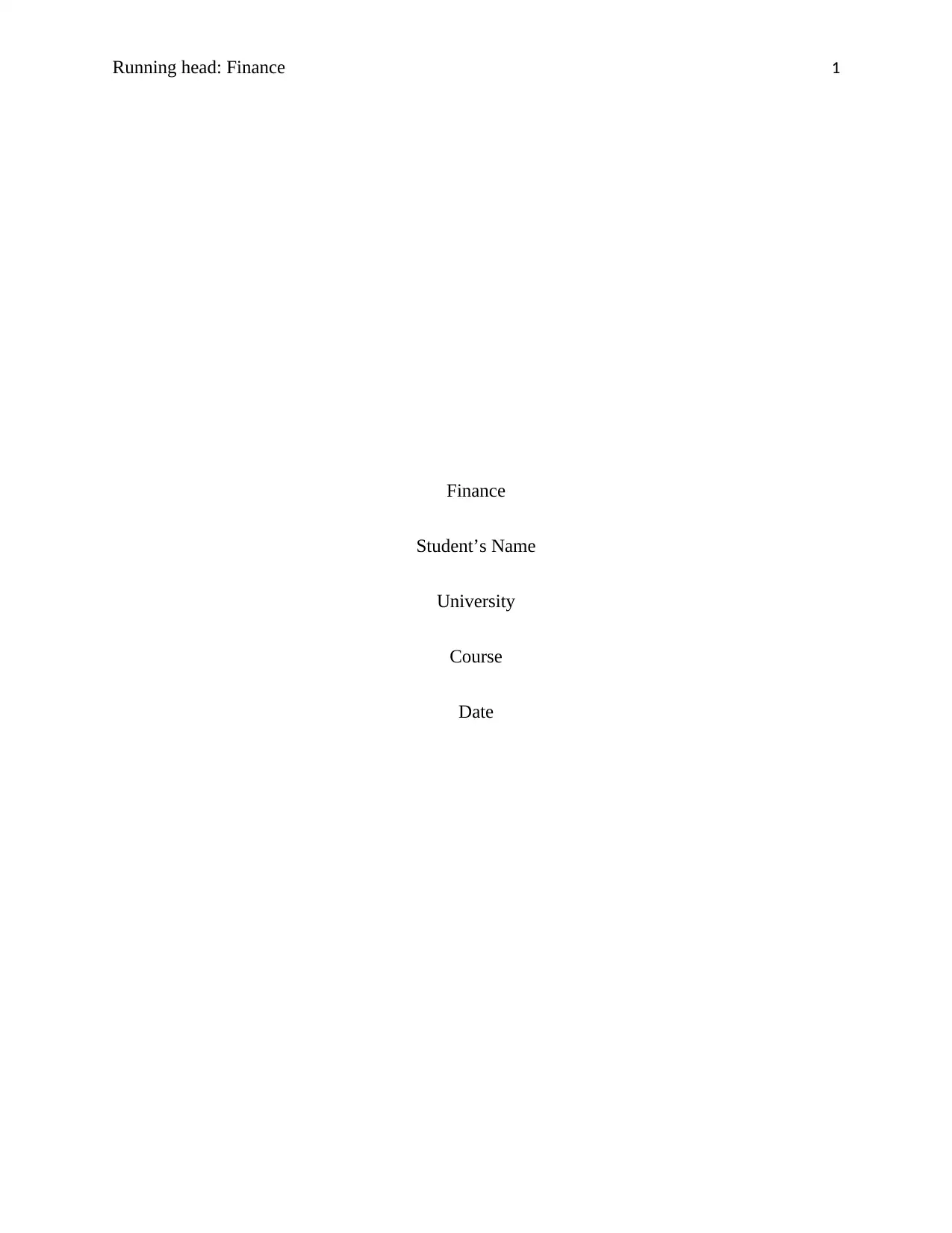
Running head: Finance 1
Finance
Student’s Name
University
Course
Date
Finance
Student’s Name
University
Course
Date
Secure Best Marks with AI Grader
Need help grading? Try our AI Grader for instant feedback on your assignments.
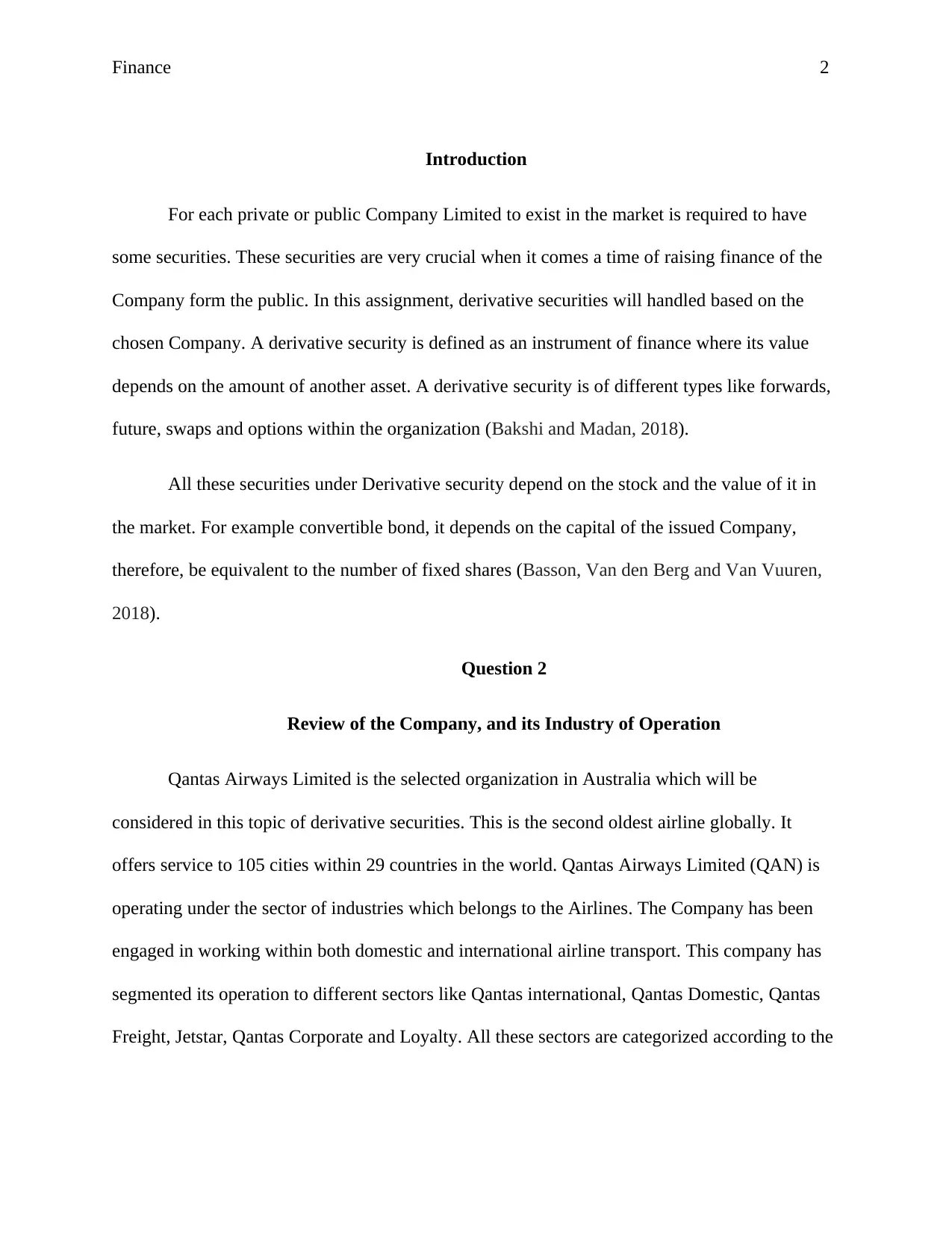
Finance 2
Introduction
For each private or public Company Limited to exist in the market is required to have
some securities. These securities are very crucial when it comes a time of raising finance of the
Company form the public. In this assignment, derivative securities will handled based on the
chosen Company. A derivative security is defined as an instrument of finance where its value
depends on the amount of another asset. A derivative security is of different types like forwards,
future, swaps and options within the organization (Bakshi and Madan, 2018).
All these securities under Derivative security depend on the stock and the value of it in
the market. For example convertible bond, it depends on the capital of the issued Company,
therefore, be equivalent to the number of fixed shares (Basson, Van den Berg and Van Vuuren,
2018).
Question 2
Review of the Company, and its Industry of Operation
Qantas Airways Limited is the selected organization in Australia which will be
considered in this topic of derivative securities. This is the second oldest airline globally. It
offers service to 105 cities within 29 countries in the world. Qantas Airways Limited (QAN) is
operating under the sector of industries which belongs to the Airlines. The Company has been
engaged in working within both domestic and international airline transport. This company has
segmented its operation to different sectors like Qantas international, Qantas Domestic, Qantas
Freight, Jetstar, Qantas Corporate and Loyalty. All these sectors are categorized according to the
Introduction
For each private or public Company Limited to exist in the market is required to have
some securities. These securities are very crucial when it comes a time of raising finance of the
Company form the public. In this assignment, derivative securities will handled based on the
chosen Company. A derivative security is defined as an instrument of finance where its value
depends on the amount of another asset. A derivative security is of different types like forwards,
future, swaps and options within the organization (Bakshi and Madan, 2018).
All these securities under Derivative security depend on the stock and the value of it in
the market. For example convertible bond, it depends on the capital of the issued Company,
therefore, be equivalent to the number of fixed shares (Basson, Van den Berg and Van Vuuren,
2018).
Question 2
Review of the Company, and its Industry of Operation
Qantas Airways Limited is the selected organization in Australia which will be
considered in this topic of derivative securities. This is the second oldest airline globally. It
offers service to 105 cities within 29 countries in the world. Qantas Airways Limited (QAN) is
operating under the sector of industries which belongs to the Airlines. The Company has been
engaged in working within both domestic and international airline transport. This company has
segmented its operation to different sectors like Qantas international, Qantas Domestic, Qantas
Freight, Jetstar, Qantas Corporate and Loyalty. All these sectors are categorized according to the
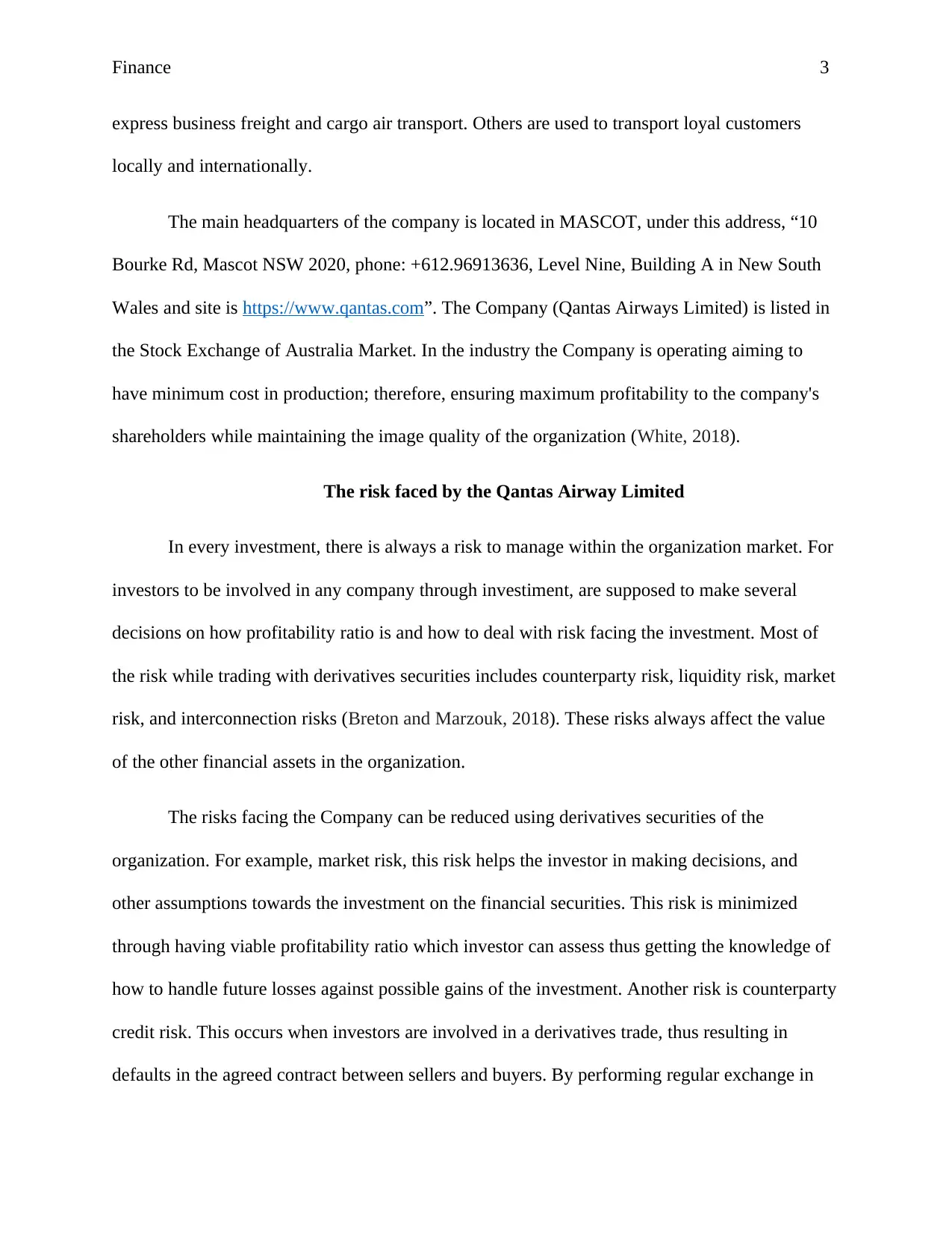
Finance 3
express business freight and cargo air transport. Others are used to transport loyal customers
locally and internationally.
The main headquarters of the company is located in MASCOT, under this address, “10
Bourke Rd, Mascot NSW 2020, phone: +612.96913636, Level Nine, Building A in New South
Wales and site is https://www.qantas.com”. The Company (Qantas Airways Limited) is listed in
the Stock Exchange of Australia Market. In the industry the Company is operating aiming to
have minimum cost in production; therefore, ensuring maximum profitability to the company's
shareholders while maintaining the image quality of the organization (White, 2018).
The risk faced by the Qantas Airway Limited
In every investment, there is always a risk to manage within the organization market. For
investors to be involved in any company through investiment, are supposed to make several
decisions on how profitability ratio is and how to deal with risk facing the investment. Most of
the risk while trading with derivatives securities includes counterparty risk, liquidity risk, market
risk, and interconnection risks (Breton and Marzouk, 2018). These risks always affect the value
of the other financial assets in the organization.
The risks facing the Company can be reduced using derivatives securities of the
organization. For example, market risk, this risk helps the investor in making decisions, and
other assumptions towards the investment on the financial securities. This risk is minimized
through having viable profitability ratio which investor can assess thus getting the knowledge of
how to handle future losses against possible gains of the investment. Another risk is counterparty
credit risk. This occurs when investors are involved in a derivatives trade, thus resulting in
defaults in the agreed contract between sellers and buyers. By performing regular exchange in
express business freight and cargo air transport. Others are used to transport loyal customers
locally and internationally.
The main headquarters of the company is located in MASCOT, under this address, “10
Bourke Rd, Mascot NSW 2020, phone: +612.96913636, Level Nine, Building A in New South
Wales and site is https://www.qantas.com”. The Company (Qantas Airways Limited) is listed in
the Stock Exchange of Australia Market. In the industry the Company is operating aiming to
have minimum cost in production; therefore, ensuring maximum profitability to the company's
shareholders while maintaining the image quality of the organization (White, 2018).
The risk faced by the Qantas Airway Limited
In every investment, there is always a risk to manage within the organization market. For
investors to be involved in any company through investiment, are supposed to make several
decisions on how profitability ratio is and how to deal with risk facing the investment. Most of
the risk while trading with derivatives securities includes counterparty risk, liquidity risk, market
risk, and interconnection risks (Breton and Marzouk, 2018). These risks always affect the value
of the other financial assets in the organization.
The risks facing the Company can be reduced using derivatives securities of the
organization. For example, market risk, this risk helps the investor in making decisions, and
other assumptions towards the investment on the financial securities. This risk is minimized
through having viable profitability ratio which investor can assess thus getting the knowledge of
how to handle future losses against possible gains of the investment. Another risk is counterparty
credit risk. This occurs when investors are involved in a derivatives trade, thus resulting in
defaults in the agreed contract between sellers and buyers. By performing regular exchange in
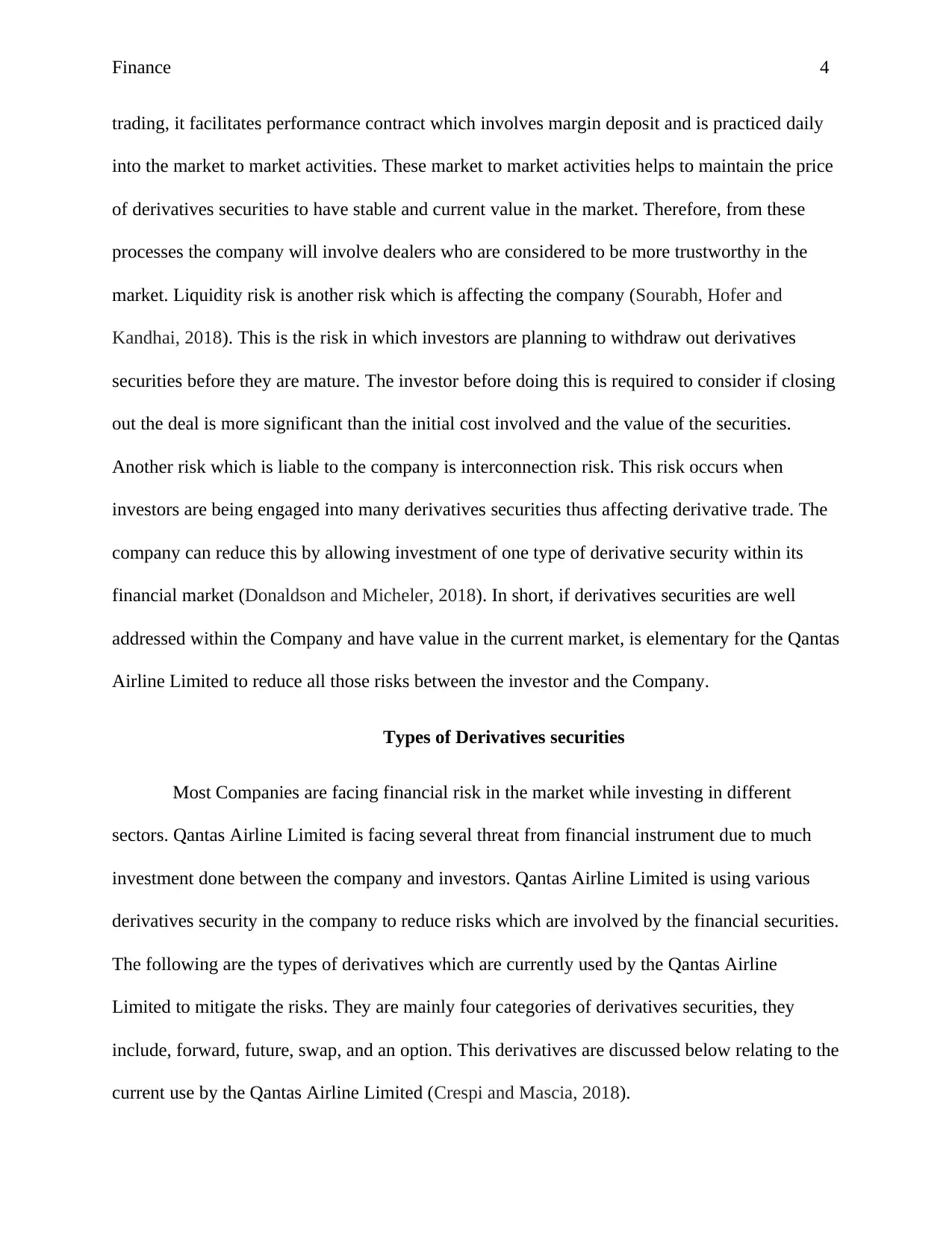
Finance 4
trading, it facilitates performance contract which involves margin deposit and is practiced daily
into the market to market activities. These market to market activities helps to maintain the price
of derivatives securities to have stable and current value in the market. Therefore, from these
processes the company will involve dealers who are considered to be more trustworthy in the
market. Liquidity risk is another risk which is affecting the company (Sourabh, Hofer and
Kandhai, 2018). This is the risk in which investors are planning to withdraw out derivatives
securities before they are mature. The investor before doing this is required to consider if closing
out the deal is more significant than the initial cost involved and the value of the securities.
Another risk which is liable to the company is interconnection risk. This risk occurs when
investors are being engaged into many derivatives securities thus affecting derivative trade. The
company can reduce this by allowing investment of one type of derivative security within its
financial market (Donaldson and Micheler, 2018). In short, if derivatives securities are well
addressed within the Company and have value in the current market, is elementary for the Qantas
Airline Limited to reduce all those risks between the investor and the Company.
Types of Derivatives securities
Most Companies are facing financial risk in the market while investing in different
sectors. Qantas Airline Limited is facing several threat from financial instrument due to much
investment done between the company and investors. Qantas Airline Limited is using various
derivatives security in the company to reduce risks which are involved by the financial securities.
The following are the types of derivatives which are currently used by the Qantas Airline
Limited to mitigate the risks. They are mainly four categories of derivatives securities, they
include, forward, future, swap, and an option. This derivatives are discussed below relating to the
current use by the Qantas Airline Limited (Crespi and Mascia, 2018).
trading, it facilitates performance contract which involves margin deposit and is practiced daily
into the market to market activities. These market to market activities helps to maintain the price
of derivatives securities to have stable and current value in the market. Therefore, from these
processes the company will involve dealers who are considered to be more trustworthy in the
market. Liquidity risk is another risk which is affecting the company (Sourabh, Hofer and
Kandhai, 2018). This is the risk in which investors are planning to withdraw out derivatives
securities before they are mature. The investor before doing this is required to consider if closing
out the deal is more significant than the initial cost involved and the value of the securities.
Another risk which is liable to the company is interconnection risk. This risk occurs when
investors are being engaged into many derivatives securities thus affecting derivative trade. The
company can reduce this by allowing investment of one type of derivative security within its
financial market (Donaldson and Micheler, 2018). In short, if derivatives securities are well
addressed within the Company and have value in the current market, is elementary for the Qantas
Airline Limited to reduce all those risks between the investor and the Company.
Types of Derivatives securities
Most Companies are facing financial risk in the market while investing in different
sectors. Qantas Airline Limited is facing several threat from financial instrument due to much
investment done between the company and investors. Qantas Airline Limited is using various
derivatives security in the company to reduce risks which are involved by the financial securities.
The following are the types of derivatives which are currently used by the Qantas Airline
Limited to mitigate the risks. They are mainly four categories of derivatives securities, they
include, forward, future, swap, and an option. This derivatives are discussed below relating to the
current use by the Qantas Airline Limited (Crespi and Mascia, 2018).
Secure Best Marks with AI Grader
Need help grading? Try our AI Grader for instant feedback on your assignments.
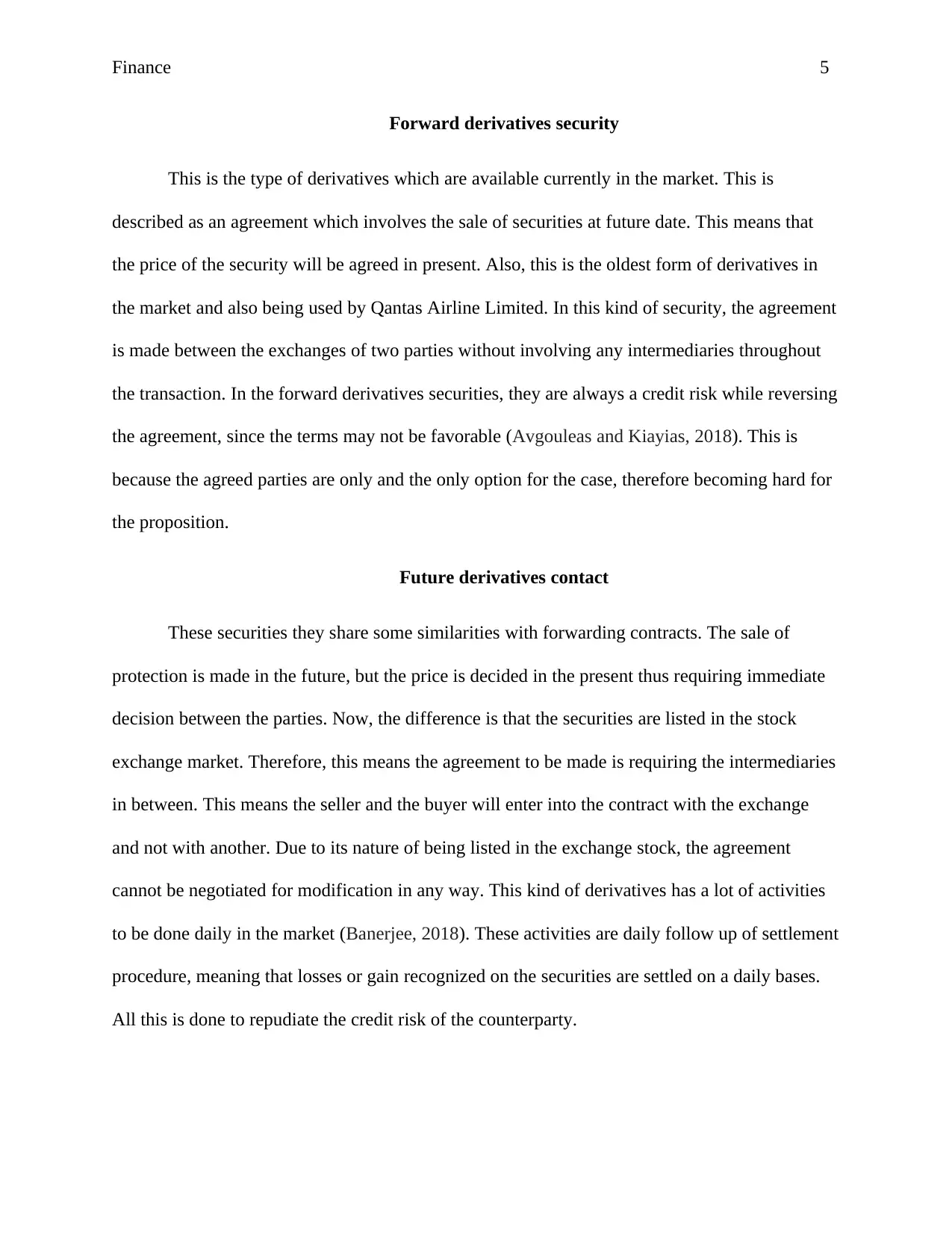
Finance 5
Forward derivatives security
This is the type of derivatives which are available currently in the market. This is
described as an agreement which involves the sale of securities at future date. This means that
the price of the security will be agreed in present. Also, this is the oldest form of derivatives in
the market and also being used by Qantas Airline Limited. In this kind of security, the agreement
is made between the exchanges of two parties without involving any intermediaries throughout
the transaction. In the forward derivatives securities, they are always a credit risk while reversing
the agreement, since the terms may not be favorable (Avgouleas and Kiayias, 2018). This is
because the agreed parties are only and the only option for the case, therefore becoming hard for
the proposition.
Future derivatives contact
These securities they share some similarities with forwarding contracts. The sale of
protection is made in the future, but the price is decided in the present thus requiring immediate
decision between the parties. Now, the difference is that the securities are listed in the stock
exchange market. Therefore, this means the agreement to be made is requiring the intermediaries
in between. This means the seller and the buyer will enter into the contract with the exchange
and not with another. Due to its nature of being listed in the exchange stock, the agreement
cannot be negotiated for modification in any way. This kind of derivatives has a lot of activities
to be done daily in the market (Banerjee, 2018). These activities are daily follow up of settlement
procedure, meaning that losses or gain recognized on the securities are settled on a daily bases.
All this is done to repudiate the credit risk of the counterparty.
Forward derivatives security
This is the type of derivatives which are available currently in the market. This is
described as an agreement which involves the sale of securities at future date. This means that
the price of the security will be agreed in present. Also, this is the oldest form of derivatives in
the market and also being used by Qantas Airline Limited. In this kind of security, the agreement
is made between the exchanges of two parties without involving any intermediaries throughout
the transaction. In the forward derivatives securities, they are always a credit risk while reversing
the agreement, since the terms may not be favorable (Avgouleas and Kiayias, 2018). This is
because the agreed parties are only and the only option for the case, therefore becoming hard for
the proposition.
Future derivatives contact
These securities they share some similarities with forwarding contracts. The sale of
protection is made in the future, but the price is decided in the present thus requiring immediate
decision between the parties. Now, the difference is that the securities are listed in the stock
exchange market. Therefore, this means the agreement to be made is requiring the intermediaries
in between. This means the seller and the buyer will enter into the contract with the exchange
and not with another. Due to its nature of being listed in the exchange stock, the agreement
cannot be negotiated for modification in any way. This kind of derivatives has a lot of activities
to be done daily in the market (Banerjee, 2018). These activities are daily follow up of settlement
procedure, meaning that losses or gain recognized on the securities are settled on a daily bases.
All this is done to repudiate the credit risk of the counterparty.
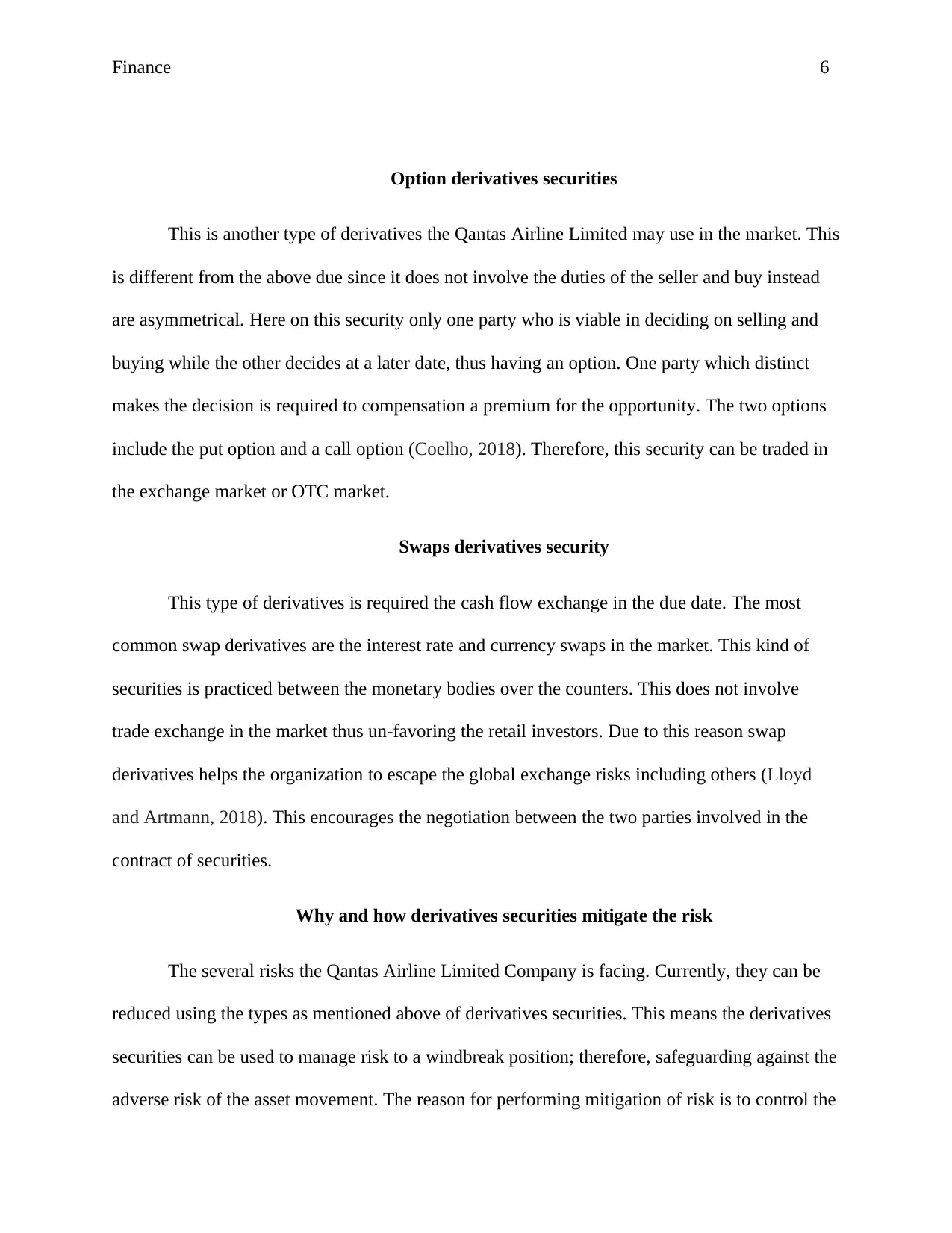
Finance 6
Option derivatives securities
This is another type of derivatives the Qantas Airline Limited may use in the market. This
is different from the above due since it does not involve the duties of the seller and buy instead
are asymmetrical. Here on this security only one party who is viable in deciding on selling and
buying while the other decides at a later date, thus having an option. One party which distinct
makes the decision is required to compensation a premium for the opportunity. The two options
include the put option and a call option (Coelho, 2018). Therefore, this security can be traded in
the exchange market or OTC market.
Swaps derivatives security
This type of derivatives is required the cash flow exchange in the due date. The most
common swap derivatives are the interest rate and currency swaps in the market. This kind of
securities is practiced between the monetary bodies over the counters. This does not involve
trade exchange in the market thus un-favoring the retail investors. Due to this reason swap
derivatives helps the organization to escape the global exchange risks including others (Lloyd
and Artmann, 2018). This encourages the negotiation between the two parties involved in the
contract of securities.
Why and how derivatives securities mitigate the risk
The several risks the Qantas Airline Limited Company is facing. Currently, they can be
reduced using the types as mentioned above of derivatives securities. This means the derivatives
securities can be used to manage risk to a windbreak position; therefore, safeguarding against the
adverse risk of the asset movement. The reason for performing mitigation of risk is to control the
Option derivatives securities
This is another type of derivatives the Qantas Airline Limited may use in the market. This
is different from the above due since it does not involve the duties of the seller and buy instead
are asymmetrical. Here on this security only one party who is viable in deciding on selling and
buying while the other decides at a later date, thus having an option. One party which distinct
makes the decision is required to compensation a premium for the opportunity. The two options
include the put option and a call option (Coelho, 2018). Therefore, this security can be traded in
the exchange market or OTC market.
Swaps derivatives security
This type of derivatives is required the cash flow exchange in the due date. The most
common swap derivatives are the interest rate and currency swaps in the market. This kind of
securities is practiced between the monetary bodies over the counters. This does not involve
trade exchange in the market thus un-favoring the retail investors. Due to this reason swap
derivatives helps the organization to escape the global exchange risks including others (Lloyd
and Artmann, 2018). This encourages the negotiation between the two parties involved in the
contract of securities.
Why and how derivatives securities mitigate the risk
The several risks the Qantas Airline Limited Company is facing. Currently, they can be
reduced using the types as mentioned above of derivatives securities. This means the derivatives
securities can be used to manage risk to a windbreak position; therefore, safeguarding against the
adverse risk of the asset movement. The reason for performing mitigation of risk is to control the
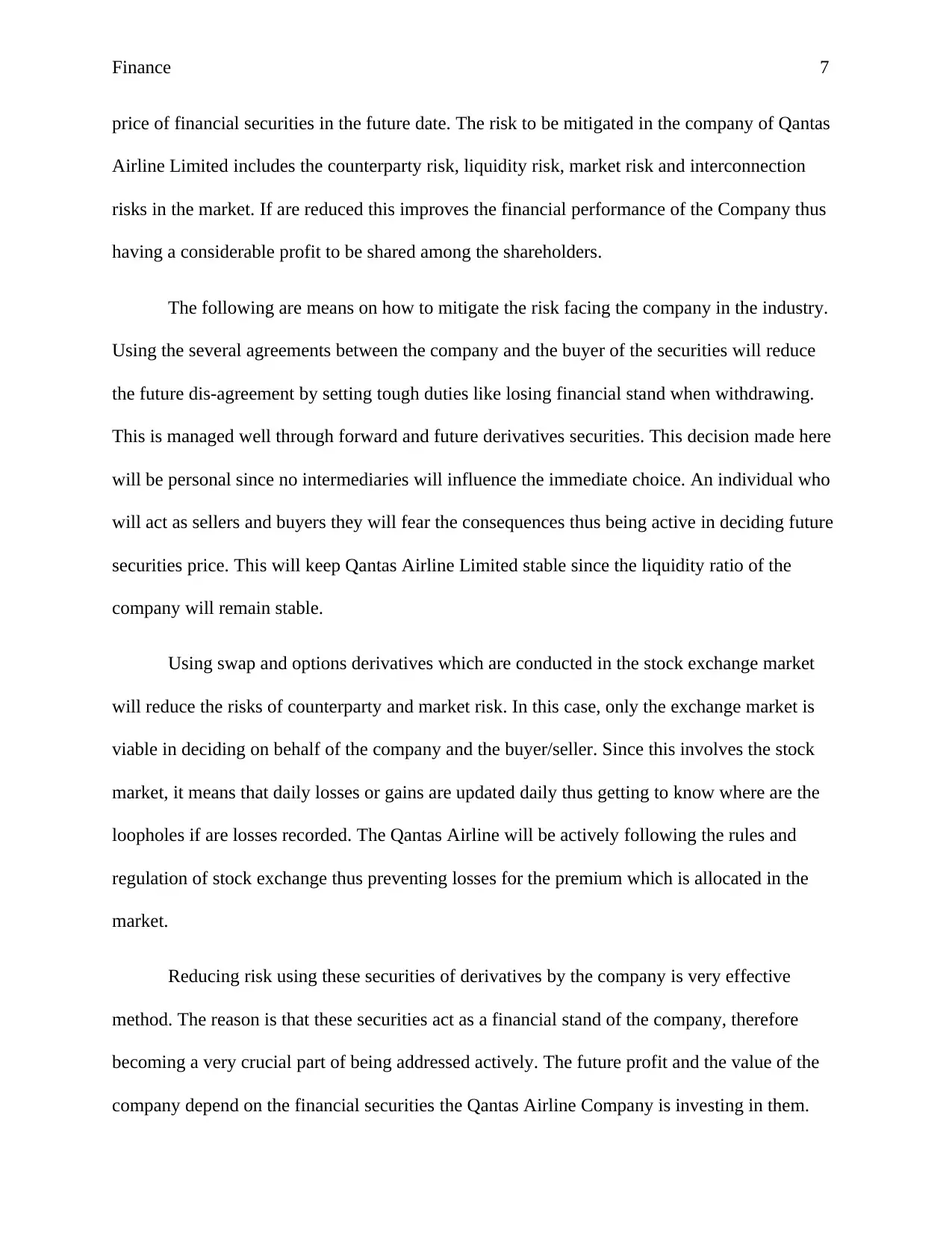
Finance 7
price of financial securities in the future date. The risk to be mitigated in the company of Qantas
Airline Limited includes the counterparty risk, liquidity risk, market risk and interconnection
risks in the market. If are reduced this improves the financial performance of the Company thus
having a considerable profit to be shared among the shareholders.
The following are means on how to mitigate the risk facing the company in the industry.
Using the several agreements between the company and the buyer of the securities will reduce
the future dis-agreement by setting tough duties like losing financial stand when withdrawing.
This is managed well through forward and future derivatives securities. This decision made here
will be personal since no intermediaries will influence the immediate choice. An individual who
will act as sellers and buyers they will fear the consequences thus being active in deciding future
securities price. This will keep Qantas Airline Limited stable since the liquidity ratio of the
company will remain stable.
Using swap and options derivatives which are conducted in the stock exchange market
will reduce the risks of counterparty and market risk. In this case, only the exchange market is
viable in deciding on behalf of the company and the buyer/seller. Since this involves the stock
market, it means that daily losses or gains are updated daily thus getting to know where are the
loopholes if are losses recorded. The Qantas Airline will be actively following the rules and
regulation of stock exchange thus preventing losses for the premium which is allocated in the
market.
Reducing risk using these securities of derivatives by the company is very effective
method. The reason is that these securities act as a financial stand of the company, therefore
becoming a very crucial part of being addressed actively. The future profit and the value of the
company depend on the financial securities the Qantas Airline Company is investing in them.
price of financial securities in the future date. The risk to be mitigated in the company of Qantas
Airline Limited includes the counterparty risk, liquidity risk, market risk and interconnection
risks in the market. If are reduced this improves the financial performance of the Company thus
having a considerable profit to be shared among the shareholders.
The following are means on how to mitigate the risk facing the company in the industry.
Using the several agreements between the company and the buyer of the securities will reduce
the future dis-agreement by setting tough duties like losing financial stand when withdrawing.
This is managed well through forward and future derivatives securities. This decision made here
will be personal since no intermediaries will influence the immediate choice. An individual who
will act as sellers and buyers they will fear the consequences thus being active in deciding future
securities price. This will keep Qantas Airline Limited stable since the liquidity ratio of the
company will remain stable.
Using swap and options derivatives which are conducted in the stock exchange market
will reduce the risks of counterparty and market risk. In this case, only the exchange market is
viable in deciding on behalf of the company and the buyer/seller. Since this involves the stock
market, it means that daily losses or gains are updated daily thus getting to know where are the
loopholes if are losses recorded. The Qantas Airline will be actively following the rules and
regulation of stock exchange thus preventing losses for the premium which is allocated in the
market.
Reducing risk using these securities of derivatives by the company is very effective
method. The reason is that these securities act as a financial stand of the company, therefore
becoming a very crucial part of being addressed actively. The future profit and the value of the
company depend on the financial securities the Qantas Airline Company is investing in them.
Paraphrase This Document
Need a fresh take? Get an instant paraphrase of this document with our AI Paraphraser
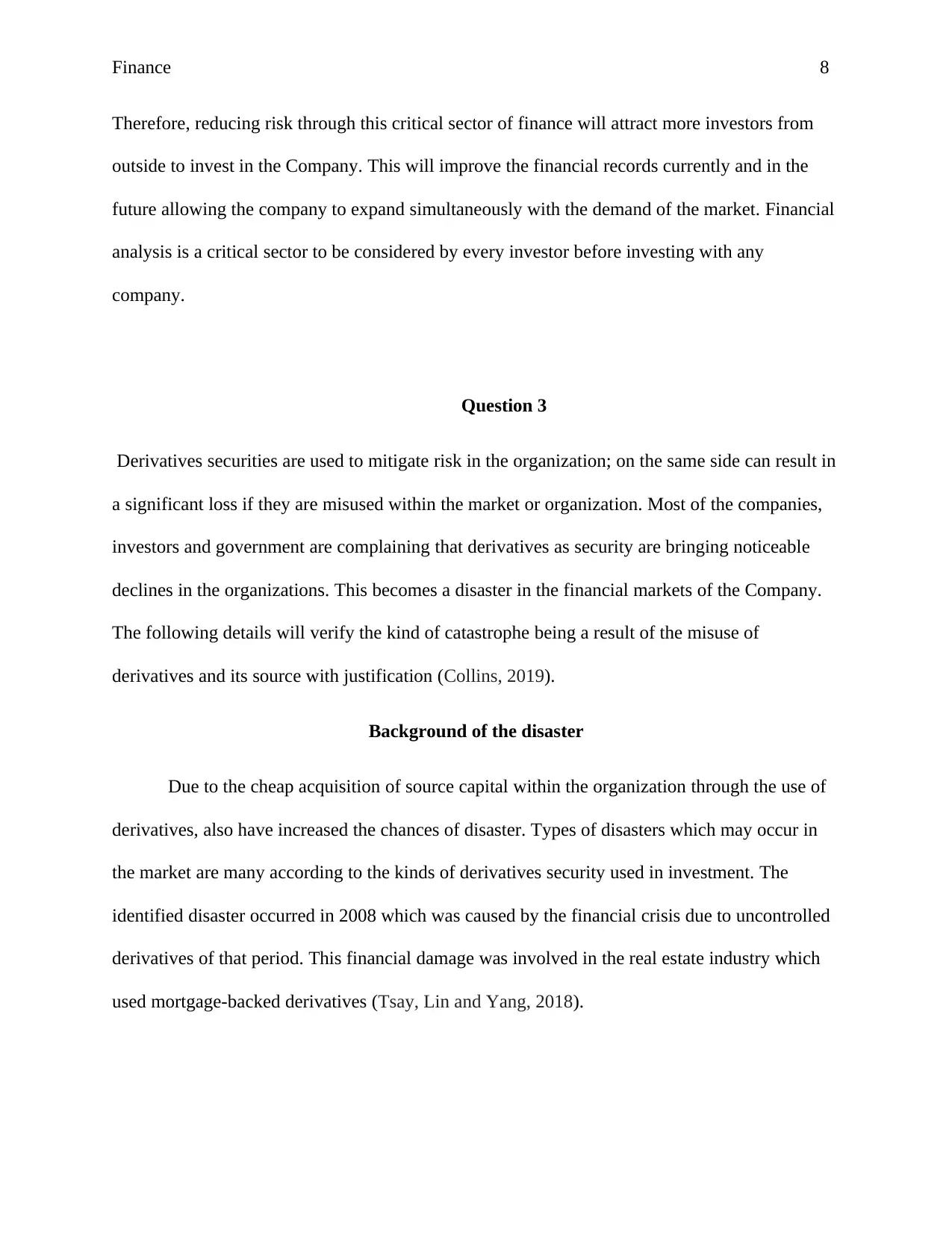
Finance 8
Therefore, reducing risk through this critical sector of finance will attract more investors from
outside to invest in the Company. This will improve the financial records currently and in the
future allowing the company to expand simultaneously with the demand of the market. Financial
analysis is a critical sector to be considered by every investor before investing with any
company.
Question 3
Derivatives securities are used to mitigate risk in the organization; on the same side can result in
a significant loss if they are misused within the market or organization. Most of the companies,
investors and government are complaining that derivatives as security are bringing noticeable
declines in the organizations. This becomes a disaster in the financial markets of the Company.
The following details will verify the kind of catastrophe being a result of the misuse of
derivatives and its source with justification (Collins, 2019).
Background of the disaster
Due to the cheap acquisition of source capital within the organization through the use of
derivatives, also have increased the chances of disaster. Types of disasters which may occur in
the market are many according to the kinds of derivatives security used in investment. The
identified disaster occurred in 2008 which was caused by the financial crisis due to uncontrolled
derivatives of that period. This financial damage was involved in the real estate industry which
used mortgage-backed derivatives (Tsay, Lin and Yang, 2018).
Therefore, reducing risk through this critical sector of finance will attract more investors from
outside to invest in the Company. This will improve the financial records currently and in the
future allowing the company to expand simultaneously with the demand of the market. Financial
analysis is a critical sector to be considered by every investor before investing with any
company.
Question 3
Derivatives securities are used to mitigate risk in the organization; on the same side can result in
a significant loss if they are misused within the market or organization. Most of the companies,
investors and government are complaining that derivatives as security are bringing noticeable
declines in the organizations. This becomes a disaster in the financial markets of the Company.
The following details will verify the kind of catastrophe being a result of the misuse of
derivatives and its source with justification (Collins, 2019).
Background of the disaster
Due to the cheap acquisition of source capital within the organization through the use of
derivatives, also have increased the chances of disaster. Types of disasters which may occur in
the market are many according to the kinds of derivatives security used in investment. The
identified disaster occurred in 2008 which was caused by the financial crisis due to uncontrolled
derivatives of that period. This financial damage was involved in the real estate industry which
used mortgage-backed derivatives (Tsay, Lin and Yang, 2018).
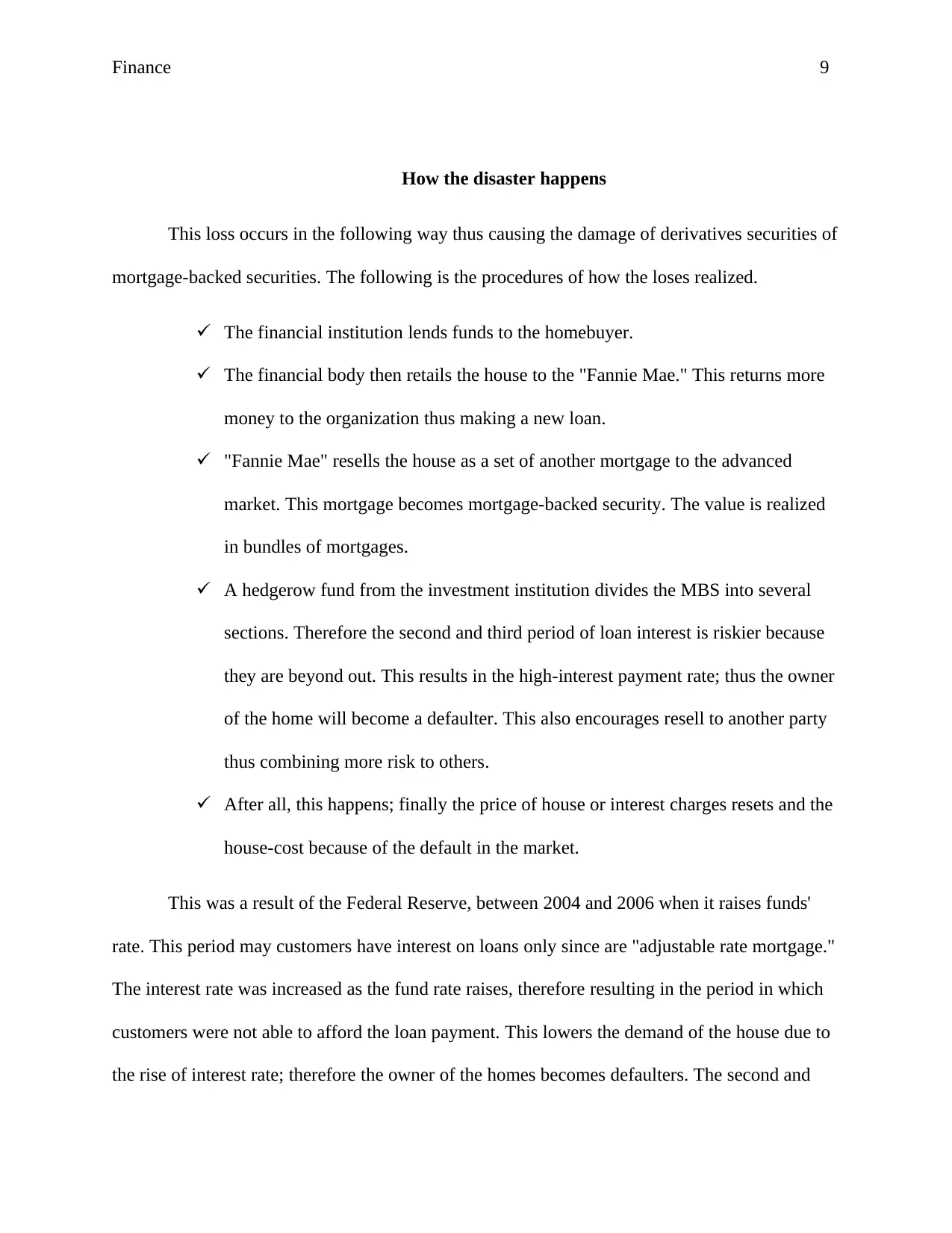
Finance 9
How the disaster happens
This loss occurs in the following way thus causing the damage of derivatives securities of
mortgage-backed securities. The following is the procedures of how the loses realized.
The financial institution lends funds to the homebuyer.
The financial body then retails the house to the "Fannie Mae." This returns more
money to the organization thus making a new loan.
"Fannie Mae" resells the house as a set of another mortgage to the advanced
market. This mortgage becomes mortgage-backed security. The value is realized
in bundles of mortgages.
A hedgerow fund from the investment institution divides the MBS into several
sections. Therefore the second and third period of loan interest is riskier because
they are beyond out. This results in the high-interest payment rate; thus the owner
of the home will become a defaulter. This also encourages resell to another party
thus combining more risk to others.
After all, this happens; finally the price of house or interest charges resets and the
house-cost because of the default in the market.
This was a result of the Federal Reserve, between 2004 and 2006 when it raises funds'
rate. This period may customers have interest on loans only since are "adjustable rate mortgage."
The interest rate was increased as the fund rate raises, therefore resulting in the period in which
customers were not able to afford the loan payment. This lowers the demand of the house due to
the rise of interest rate; therefore the owner of the homes becomes defaulters. The second and
How the disaster happens
This loss occurs in the following way thus causing the damage of derivatives securities of
mortgage-backed securities. The following is the procedures of how the loses realized.
The financial institution lends funds to the homebuyer.
The financial body then retails the house to the "Fannie Mae." This returns more
money to the organization thus making a new loan.
"Fannie Mae" resells the house as a set of another mortgage to the advanced
market. This mortgage becomes mortgage-backed security. The value is realized
in bundles of mortgages.
A hedgerow fund from the investment institution divides the MBS into several
sections. Therefore the second and third period of loan interest is riskier because
they are beyond out. This results in the high-interest payment rate; thus the owner
of the home will become a defaulter. This also encourages resell to another party
thus combining more risk to others.
After all, this happens; finally the price of house or interest charges resets and the
house-cost because of the default in the market.
This was a result of the Federal Reserve, between 2004 and 2006 when it raises funds'
rate. This period may customers have interest on loans only since are "adjustable rate mortgage."
The interest rate was increased as the fund rate raises, therefore resulting in the period in which
customers were not able to afford the loan payment. This lowers the demand of the house due to
the rise of interest rate; therefore the owner of the homes becomes defaulters. The second and
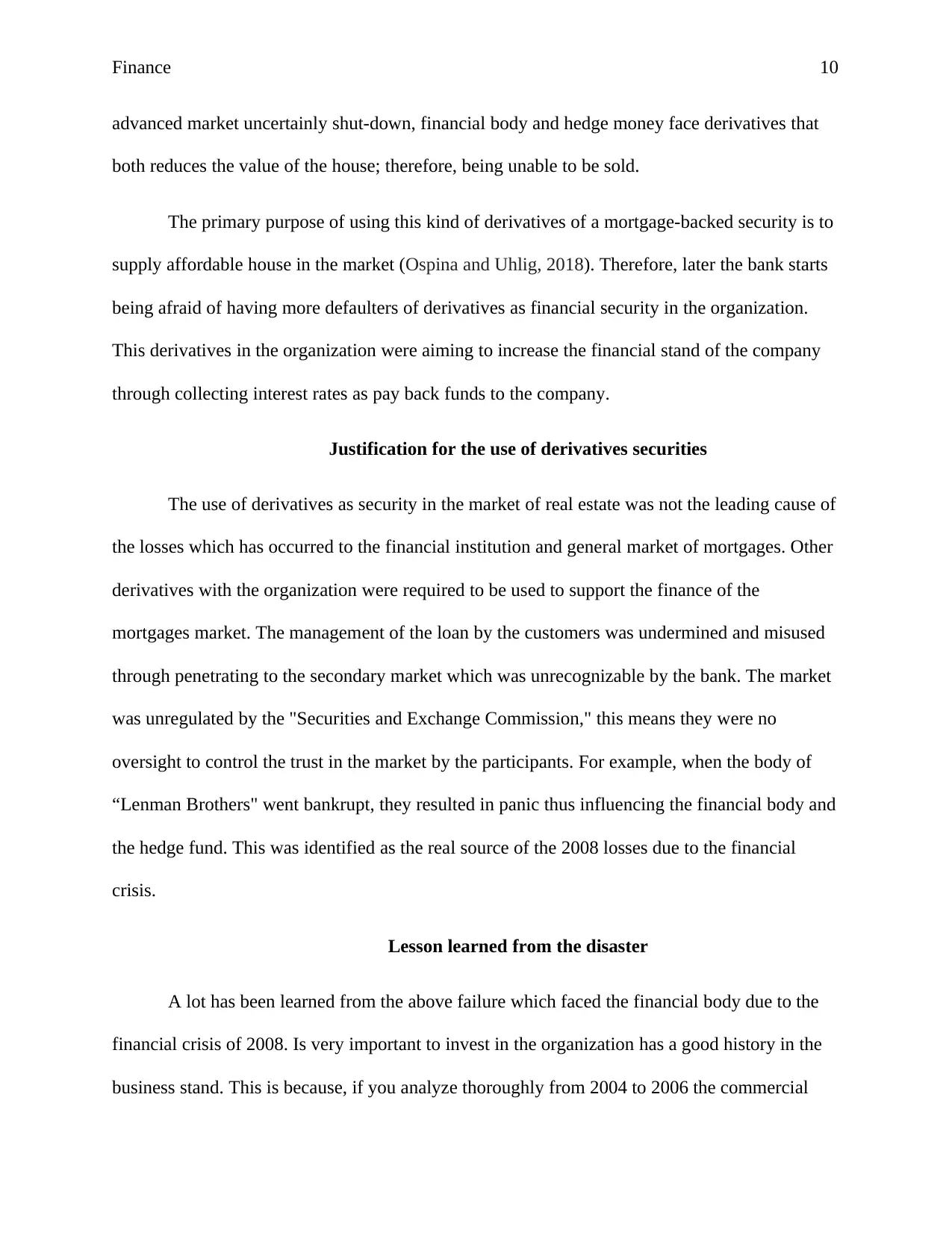
Finance 10
advanced market uncertainly shut-down, financial body and hedge money face derivatives that
both reduces the value of the house; therefore, being unable to be sold.
The primary purpose of using this kind of derivatives of a mortgage-backed security is to
supply affordable house in the market (Ospina and Uhlig, 2018). Therefore, later the bank starts
being afraid of having more defaulters of derivatives as financial security in the organization.
This derivatives in the organization were aiming to increase the financial stand of the company
through collecting interest rates as pay back funds to the company.
Justification for the use of derivatives securities
The use of derivatives as security in the market of real estate was not the leading cause of
the losses which has occurred to the financial institution and general market of mortgages. Other
derivatives with the organization were required to be used to support the finance of the
mortgages market. The management of the loan by the customers was undermined and misused
through penetrating to the secondary market which was unrecognizable by the bank. The market
was unregulated by the "Securities and Exchange Commission," this means they were no
oversight to control the trust in the market by the participants. For example, when the body of
“Lenman Brothers" went bankrupt, they resulted in panic thus influencing the financial body and
the hedge fund. This was identified as the real source of the 2008 losses due to the financial
crisis.
Lesson learned from the disaster
A lot has been learned from the above failure which faced the financial body due to the
financial crisis of 2008. Is very important to invest in the organization has a good history in the
business stand. This is because, if you analyze thoroughly from 2004 to 2006 the commercial
advanced market uncertainly shut-down, financial body and hedge money face derivatives that
both reduces the value of the house; therefore, being unable to be sold.
The primary purpose of using this kind of derivatives of a mortgage-backed security is to
supply affordable house in the market (Ospina and Uhlig, 2018). Therefore, later the bank starts
being afraid of having more defaulters of derivatives as financial security in the organization.
This derivatives in the organization were aiming to increase the financial stand of the company
through collecting interest rates as pay back funds to the company.
Justification for the use of derivatives securities
The use of derivatives as security in the market of real estate was not the leading cause of
the losses which has occurred to the financial institution and general market of mortgages. Other
derivatives with the organization were required to be used to support the finance of the
mortgages market. The management of the loan by the customers was undermined and misused
through penetrating to the secondary market which was unrecognizable by the bank. The market
was unregulated by the "Securities and Exchange Commission," this means they were no
oversight to control the trust in the market by the participants. For example, when the body of
“Lenman Brothers" went bankrupt, they resulted in panic thus influencing the financial body and
the hedge fund. This was identified as the real source of the 2008 losses due to the financial
crisis.
Lesson learned from the disaster
A lot has been learned from the above failure which faced the financial body due to the
financial crisis of 2008. Is very important to invest in the organization has a good history in the
business stand. This is because, if you analyze thoroughly from 2004 to 2006 the commercial
Secure Best Marks with AI Grader
Need help grading? Try our AI Grader for instant feedback on your assignments.
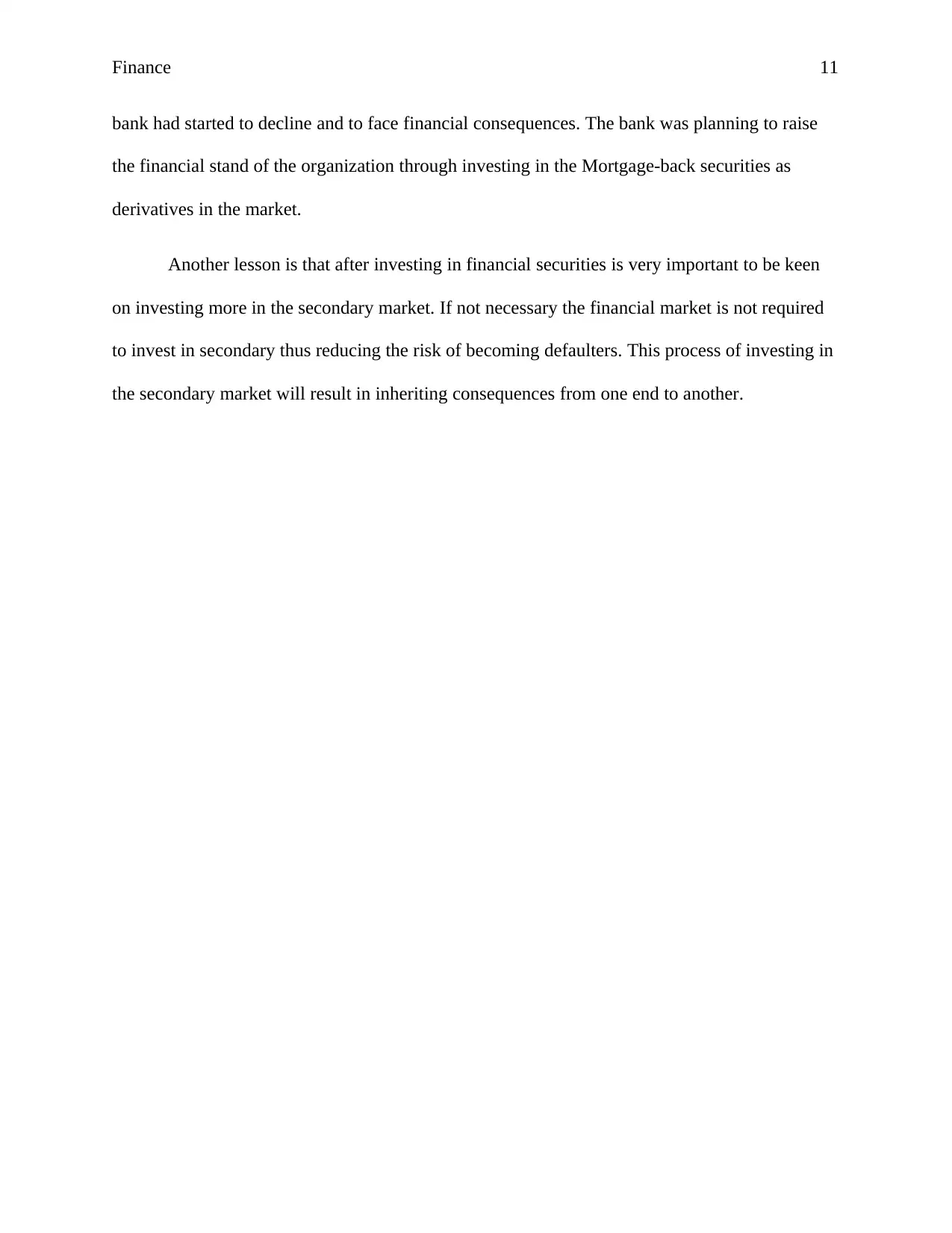
Finance 11
bank had started to decline and to face financial consequences. The bank was planning to raise
the financial stand of the organization through investing in the Mortgage-back securities as
derivatives in the market.
Another lesson is that after investing in financial securities is very important to be keen
on investing more in the secondary market. If not necessary the financial market is not required
to invest in secondary thus reducing the risk of becoming defaulters. This process of investing in
the secondary market will result in inheriting consequences from one end to another.
bank had started to decline and to face financial consequences. The bank was planning to raise
the financial stand of the organization through investing in the Mortgage-back securities as
derivatives in the market.
Another lesson is that after investing in financial securities is very important to be keen
on investing more in the secondary market. If not necessary the financial market is not required
to invest in secondary thus reducing the risk of becoming defaulters. This process of investing in
the secondary market will result in inheriting consequences from one end to another.
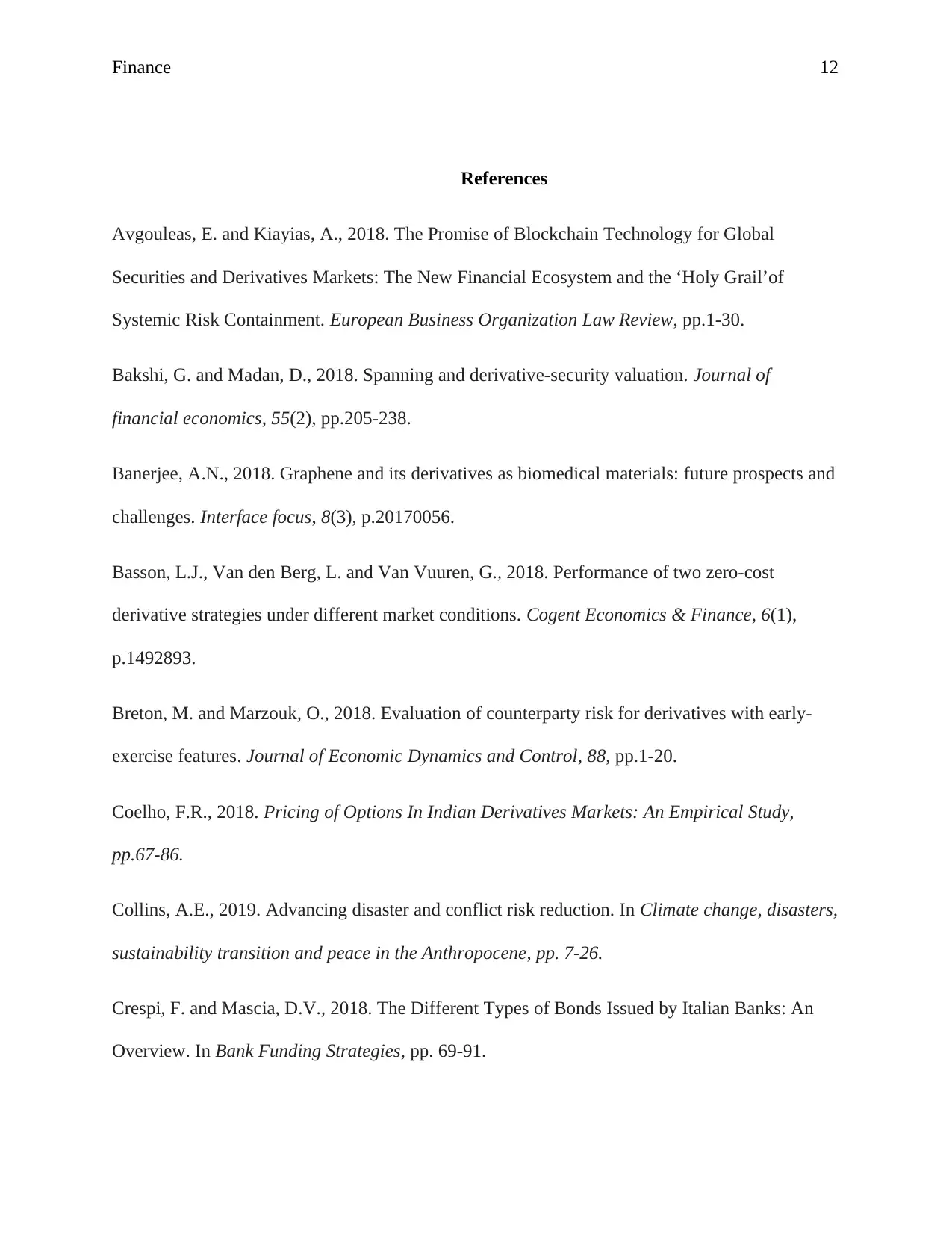
Finance 12
References
Avgouleas, E. and Kiayias, A., 2018. The Promise of Blockchain Technology for Global
Securities and Derivatives Markets: The New Financial Ecosystem and the ‘Holy Grail’of
Systemic Risk Containment. European Business Organization Law Review, pp.1-30.
Bakshi, G. and Madan, D., 2018. Spanning and derivative-security valuation. Journal of
financial economics, 55(2), pp.205-238.
Banerjee, A.N., 2018. Graphene and its derivatives as biomedical materials: future prospects and
challenges. Interface focus, 8(3), p.20170056.
Basson, L.J., Van den Berg, L. and Van Vuuren, G., 2018. Performance of two zero-cost
derivative strategies under different market conditions. Cogent Economics & Finance, 6(1),
p.1492893.
Breton, M. and Marzouk, O., 2018. Evaluation of counterparty risk for derivatives with early-
exercise features. Journal of Economic Dynamics and Control, 88, pp.1-20.
Coelho, F.R., 2018. Pricing of Options In Indian Derivatives Markets: An Empirical Study,
pp.67-86.
Collins, A.E., 2019. Advancing disaster and conflict risk reduction. In Climate change, disasters,
sustainability transition and peace in the Anthropocene, pp. 7-26.
Crespi, F. and Mascia, D.V., 2018. The Different Types of Bonds Issued by Italian Banks: An
Overview. In Bank Funding Strategies, pp. 69-91.
References
Avgouleas, E. and Kiayias, A., 2018. The Promise of Blockchain Technology for Global
Securities and Derivatives Markets: The New Financial Ecosystem and the ‘Holy Grail’of
Systemic Risk Containment. European Business Organization Law Review, pp.1-30.
Bakshi, G. and Madan, D., 2018. Spanning and derivative-security valuation. Journal of
financial economics, 55(2), pp.205-238.
Banerjee, A.N., 2018. Graphene and its derivatives as biomedical materials: future prospects and
challenges. Interface focus, 8(3), p.20170056.
Basson, L.J., Van den Berg, L. and Van Vuuren, G., 2018. Performance of two zero-cost
derivative strategies under different market conditions. Cogent Economics & Finance, 6(1),
p.1492893.
Breton, M. and Marzouk, O., 2018. Evaluation of counterparty risk for derivatives with early-
exercise features. Journal of Economic Dynamics and Control, 88, pp.1-20.
Coelho, F.R., 2018. Pricing of Options In Indian Derivatives Markets: An Empirical Study,
pp.67-86.
Collins, A.E., 2019. Advancing disaster and conflict risk reduction. In Climate change, disasters,
sustainability transition and peace in the Anthropocene, pp. 7-26.
Crespi, F. and Mascia, D.V., 2018. The Different Types of Bonds Issued by Italian Banks: An
Overview. In Bank Funding Strategies, pp. 69-91.
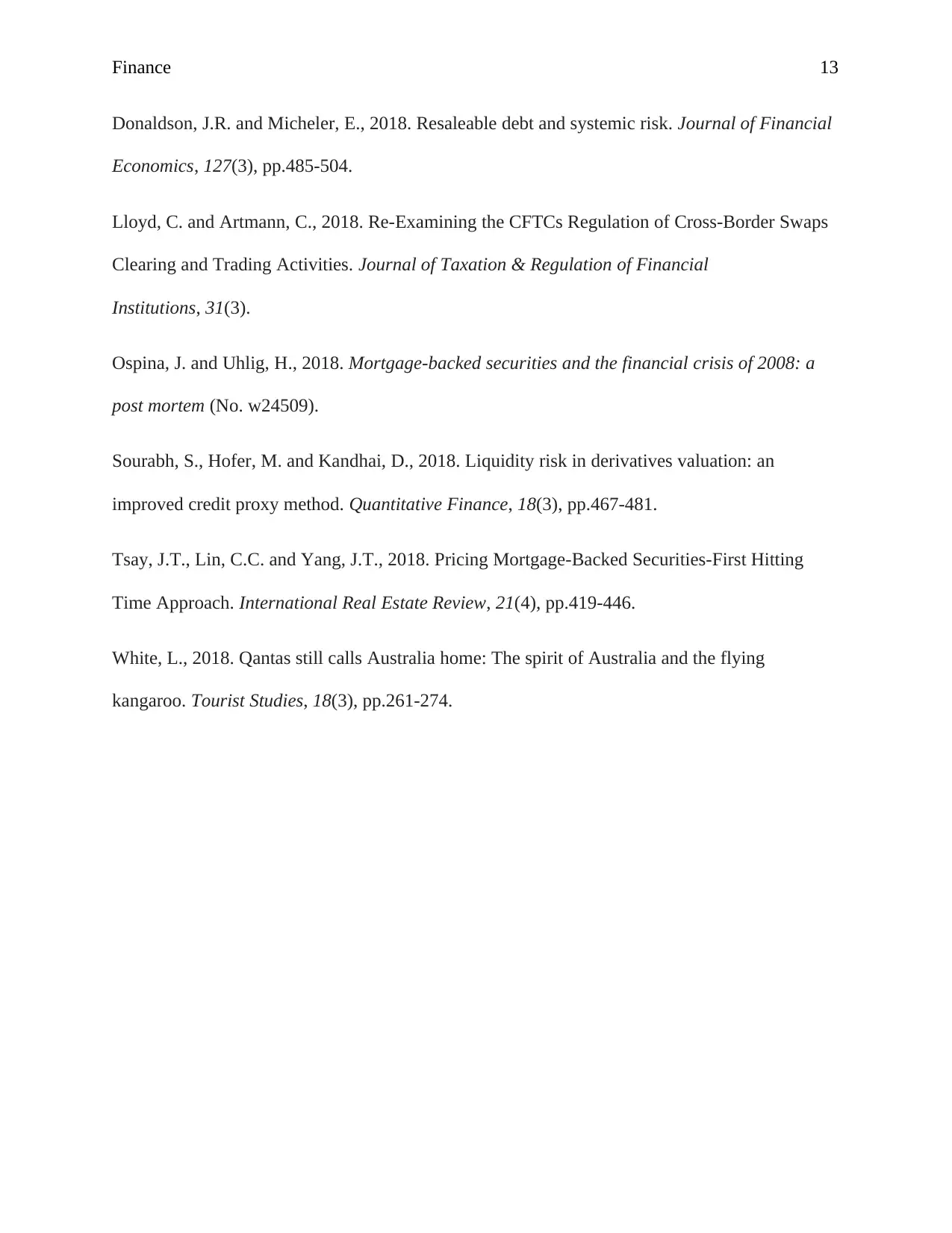
Finance 13
Donaldson, J.R. and Micheler, E., 2018. Resaleable debt and systemic risk. Journal of Financial
Economics, 127(3), pp.485-504.
Lloyd, C. and Artmann, C., 2018. Re-Examining the CFTCs Regulation of Cross-Border Swaps
Clearing and Trading Activities. Journal of Taxation & Regulation of Financial
Institutions, 31(3).
Ospina, J. and Uhlig, H., 2018. Mortgage-backed securities and the financial crisis of 2008: a
post mortem (No. w24509).
Sourabh, S., Hofer, M. and Kandhai, D., 2018. Liquidity risk in derivatives valuation: an
improved credit proxy method. Quantitative Finance, 18(3), pp.467-481.
Tsay, J.T., Lin, C.C. and Yang, J.T., 2018. Pricing Mortgage-Backed Securities-First Hitting
Time Approach. International Real Estate Review, 21(4), pp.419-446.
White, L., 2018. Qantas still calls Australia home: The spirit of Australia and the flying
kangaroo. Tourist Studies, 18(3), pp.261-274.
Donaldson, J.R. and Micheler, E., 2018. Resaleable debt and systemic risk. Journal of Financial
Economics, 127(3), pp.485-504.
Lloyd, C. and Artmann, C., 2018. Re-Examining the CFTCs Regulation of Cross-Border Swaps
Clearing and Trading Activities. Journal of Taxation & Regulation of Financial
Institutions, 31(3).
Ospina, J. and Uhlig, H., 2018. Mortgage-backed securities and the financial crisis of 2008: a
post mortem (No. w24509).
Sourabh, S., Hofer, M. and Kandhai, D., 2018. Liquidity risk in derivatives valuation: an
improved credit proxy method. Quantitative Finance, 18(3), pp.467-481.
Tsay, J.T., Lin, C.C. and Yang, J.T., 2018. Pricing Mortgage-Backed Securities-First Hitting
Time Approach. International Real Estate Review, 21(4), pp.419-446.
White, L., 2018. Qantas still calls Australia home: The spirit of Australia and the flying
kangaroo. Tourist Studies, 18(3), pp.261-274.
1 out of 13
Related Documents
Your All-in-One AI-Powered Toolkit for Academic Success.
+13062052269
info@desklib.com
Available 24*7 on WhatsApp / Email
![[object Object]](/_next/static/media/star-bottom.7253800d.svg)
Unlock your academic potential
© 2024 | Zucol Services PVT LTD | All rights reserved.




